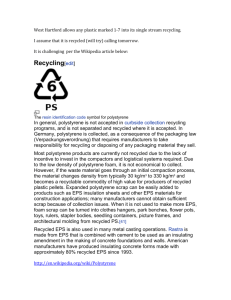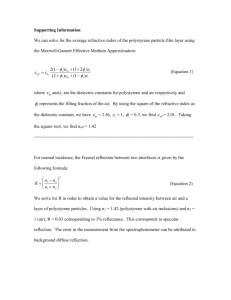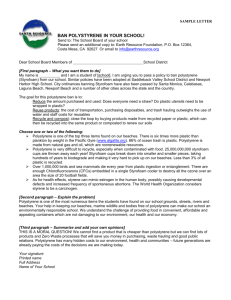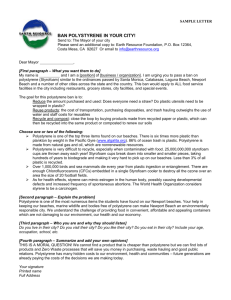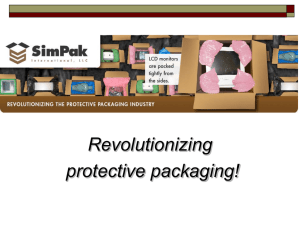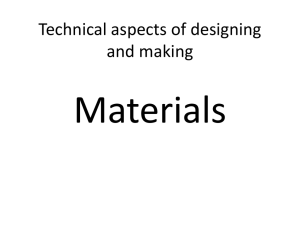Sustainable Purchasing Guide Void Fillers
advertisement
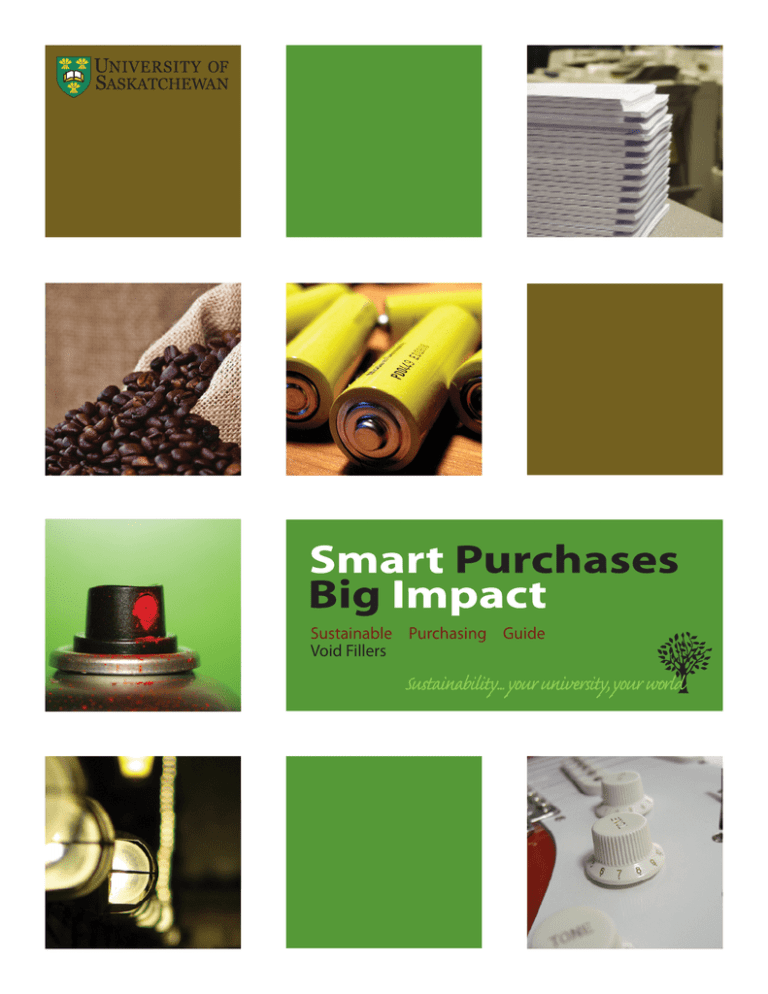
Sustainable Purchasing Guide Void Fillers Void Fillers Introduction This section provides information on currently available options for void fillers that can help to move the University of Saskatchewan toward its sustainability goals. Living within the boundaries of our sustainability objectives requires us to apply two main strategies: Dematerialization requires that we reduce the amount of materials as much as possible; and that we continually move toward the use of 100% recycled content. Substitution requires that we find less harmful materials to replace those that currently damage and are not recyclable. Sustainable purchasing is about including social, environmental, financial and performance factors in a systematic way. It involves thinking about the reasons for using the product (the service) and assessing how these services could be best met. If a product is needed, sustainable purchasing involves considering how products are made, what they are made of, where they come from and how they will be used and disposed. Finally, remember that this is an evolving document – it will change with new information as our understanding of sustainability impacts and potential solutions improves. Purchasing Services Tel: Email: (306) 966-6704 purchasing.services@usask.ca Office of Sustainability Tel: Email: (306) 966-1236 fmdsustainability@usask.ca Wherever possible CHOOSE products that employ a combination of characteristics listed in the left hand column, and AVOID products that demonstrate characteristic in the right-hand column. CHOOSE AVOID • • • • • • Expanded polystyrene Reusable packaging Recycled contents Recyclable contents Paper-based products Biodegradable and biocompatible contents Option: Reuse polystyrene packaging Strategy: Dematerialization (SO 1, 2, 3, 4) Expanded Polystyrene, more commonly known as“Styrofoam,”is widely used for product packaging. Packing “peanuts” or formed blocks are currently the most widely used product protection materials and pose many environmental hazards. Packing “peanuts” are an inexpensive way to ensure products do not get damaged during shipping, but they are not good for the environment. When disposed of in landfills, expanded polystyrene does not degrade. Reusing these “peanuts” diverts them from the landfill and reduces the need to manufacture new ones. Most UPS stores, mail centers or post offices will accept returned packing peanuts to be reused. Option: Recyclable and recycled packaging Strategy: Dematerialization (SO 1, 2, 3, 4) Polystyrene blocks (often used to protect electronics or in rectangular blocks for other packaging uses) are a #6 plastic material. Polystyrene is not easily recycled because of its light weight (especially if in the expanded form) and its low scrap value. For instance, it is not accepted by Saskatoon Curbside Recycling, although some regions do have polystyrene recycling facilities. There are other types of expanded plastic products that use #2 or #4 plastic that can be recycled with other plastics. Ideally, choose a company that has a take-back program for their plastics to be reused (closed-loop). If this is not an option, ask the companies that you are currently using to consider developing these types of programs. Another option is to find local companies that are able to recycle plastics, although this option would incur costs. To ensure that you are choosing packaging products that will be accepted by recycling facilities: • Avoid composite packaging that incorporates a number of different materials. continued on page 2 … Sustainable Purchasing Guide 1 • Choose packaging that has been designed for the separation of individual parts for recycling if composite packaging is necessary. • Choose products that are free of materials that will interfere with the recycling process, e.g. labels, inks, colouring, adhesives, seals, handles, inserts, liners, laminates and closures. • Look for companies that have a take-back program for their plastics to be reused (closed-loop). • Avoid coatings or films (such as a polyester film), where possible. Recycled plastics reduce the amount of non-renewable petroleum or natural gas used as feedstock for void fillers. This reduces the fossil fuels used, thus reducing the substances from the earth’s crust that build up in nature and the chemical compounds created by the combustion of fossil fuels. Option: Packaging with biodegradable or biocompatible materials Strategy: Substitution – nature-like (SO 1, 2, 3, 4) Several biocompatible protective packaging peanuts are available on the market. These void fillers and product protectors are very similar both visually and functionally to polyurethane peanuts, but are derived from a renewable source and are relatively inexpensive. These products are generally made from an organic starchy material, such as corn or potato, which breaks down into small particles that are inert or even beneficial to the environment. These biocompatible products result in less waste entering the environment. Option: High post-consumer or post-industrial recycled inflatable plastic bags Strategy: Substitution (SO 1, 2, 3, 4) Option: Paper packing materials Strategy: Substitution (SO 1, 2, 3, 4) Moulded paperboard serves the same protective function of polystyrene blocks, yet it is widely accepted as recyclable and can be made from recycled fibres. Moulded paper can be tightly fitted around a particular product. Packaging in this way not only reduces waste by eliminating the need for interior void-fillers but it also provides a shell that is easy to stack and can take up less space to store and transport. Multi-layer paper is a similar concept to inflatable plastic bags. Multi-layer paper systems bond together two or three plies of paper which are slightly crumpled to create variable or predetermined lengths of cushioning/void fill material. Dunnage paper “peanuts” are a good substitute for polyurethane “peanuts.” Dunnage (also referred to as Kraft Paper) refers to off-cut or spare pieces of scrap wood. The recycled paper product can be tightly twisted into individual pellets which are used as void fillers in the shipment of fragile packaged goods. Recycled plastics usually result from combining and melting pellets of recycled plastic and virgin plastic into a roll of film. The percentage of recycled content can range from 0 to 100%. A packaging product now on the market consists of a continuous, two-ply thermoplastic film material, sealed in a manner that forms superimposed panels into individual, inflatable bags that are repeated and separable, forming a continuous packaging material. The wrapping material contains recycled plastic and can be recycled. In some cases, it may also contain biodegradable plastic. Recycled plastic reduces the amount of non-renewable petroleum or natural gas needed as feedstock for plastic containers. This reduces the amount of fossil fuels used, thus reducing the substances from the earth’s crust that build up in nature and the chemical compounds created by the combustion of fossil fuels. Paper products can be made from 100% recycled materials. They are both biodegradable and inexpensive. Paper can be unbleached, therefore emitting no pollutants. Recycling facilities for paper products are common and easily accessible. For more information on the types of paper available see the paper products guideline. continued on page 3 … Sustainable Purchasing Guide 2 Arriving at the currently preferred options 1. Identify the service Void fillers are used to reduce the chance of damage in the shipment of goods. 2. Assess the need The University of Saskatchewan does not produce most of the products it requires on campus and therefore requires the shipment of goods to campus. These must be packaged in manner that reduces the opportunity for damage. 3. Identify the contents Currently, most packaging void fillers are made of expanded polystyrene (Styrofoam) which contains the following components: • Benzene is a petrochemical extracted from coal, and also found in gasoline. • Styrene is “cracked” or extracted from petroleum. • Blowing agents – chlorofluorocarbons (CFCs) and hydrochlorofluorocarbons (HCFCs). 4. Identify sustainability impacts i. …systematically increasing concentrations of substances from the earth’s crust? • Fossil fuels are combusted to provide energy during the extraction of raw materials, transportation, and production of plastics. The combustion of fossil fuels leads to an increase in concentration of substances extracted from the earth’s crust in nature (CO2, CO and SOx). Increasing concentrations of these substances in nature can contribute to a number of negative effects such as climate change and acid rain, as well as to negative human health impacts. • Benzene is extracted from coal. • Petroleum is also used as a feedstock for most polystyrene and is a material that is extracted at a rate much greater than its redeposit back into the earth’s crust. ii. …systematically increasing concentrations of substances produced by society? • Petroleum is also used as a feedstock for most polystyrene. The combustion of fossil fuels produces a number of chemical compounds (e.g. nitrogen oxides) that build up in the atmosphere. • Volatile organic compounds (VOCs) are used in polystyrene production as adhesives. VOCs do not break down easily and accumulate in nature, contributing to a variety of problems such as the formation of smog. • Plastic polystyrene does not breakdown, cluttering the Earth’s surface and threatening wildlife, particularly marine life who often mistake floating plastic with food. • Up until the late 1970’s, Chlorofluorocarbons (CFCs) were used as the blowing agents for Styrofoam production. CFCs were replaced with HCFCs combined with Ethylene. HCFC, though less destructive than its chemical cousins, CFC-11 and CFC-12, is still a greenhouse gas and harmful to the ozone layer. iii …systematically degrading nature by physical means? • Expanded polystyrene is not recyclable and is currently over-burdening landfills, displacing humans and the natural habitats. iv. …systematically undermining people’s ability to meet their basic human needs? • Benzene, a component of expanded polystyrene, is considered a mutagen and a carcinogen. • Polystyrene is lipid soluble, meaning it is stored in the body’s fat stores and not passed through the body like watersoluble compounds. Polystyrene contains Styrene and Benzene which are listed by the U.S. Environmental Protection Agency as a suspected carcinogenic and neurotoxin. There are concerns about these chemicals leaching into food and beverages from containers. • A number of the compounds produced by the combustion of fossil fuels and other processes (e.g. nitrogen oxides, carbon monoxide, sulphur oxides, particulate matter) negatively effect human health. Sustainable Purchasing Guide 3 5. Envision sustainable Sustainability requires that materials be kept within natural cycles (where materials can be easily assimilated by nature) or tight technical cycles (where materials can be reused indefinitely in processes that do not move us away from our sustainability objectives). Sustainable packaging materials would not contribute to systematic increases of substances extracted from the earth’s crust, or of human-made substances. This means that they would either (1) not contain any substances that could systematically increase in nature or (2) that these substances would be taken back and re-used entirely. Packing products would either be produced from bio-based materials that natural ecosystems can easily assimilate, or be 100% recycled. The energy used for extracting raw materials, producing and transporting the containers would be generated from sustainable renewable sources in a carbon-neutral way, so that no carbon was allowed to systematically increase in the atmosphere and biosphere. 6. Identify and prioritize alternatives To identify the best options, review the Current Options on page one and choose the most appropriate alternative by using the following three criteria for assessment: a)Does the product or service move us in the right direction with regards to our four Sustainability Objectives? b)Does the product or service create a flexible platform for the next step toward sustainability? c)Is the decision financially viable? Resources and Additional Information 1. National Research Council Canada. http://irc.nrc-cnrc.gc.ca/cbd/cbd019e.html 2. http://www.stanford.edu/dept/rde/shs/sustain.htm 3. Polystyrene and Health www.ejnet.org/plastics/polystyrene/health.html 4. A. Kemer, “Cradle to Grave: The Lifecycle of Styrofoam,” Spring 2003 5. World Health Organization, International Agency For Research On Cancer. http://monographs.iarc.fr/ENG/Monographs/vol19/ volume19.pdf 6. U.S. Environmental Protection Agency: Styrene. www.epa.gov/ttn/atw/hlthef/styrene.html 7. U.S. Environmental Protection Agency: Benzene. www.epa.gov/airtoxics/hlthef/benzene.html This guide was made possible through the generosity of the Whistler 2012 project, which shared its template and much of its research. Sustainable Purchasing Guide 4
